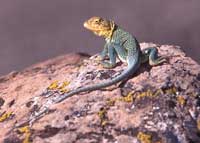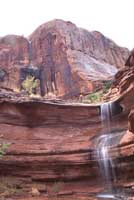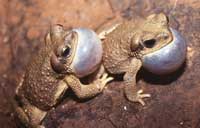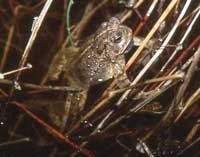 Collared lizard. Midget-faded rattlesnake. Western whiptail. Gopher snake. These and many other reptiles roam the desert during the warm months, seeking prey and raising young. Their presence is expected as part of the desert’s fauna, but another group of wildlife is “toadally” unexpected.
Collared lizard. Midget-faded rattlesnake. Western whiptail. Gopher snake. These and many other reptiles roam the desert during the warm months, seeking prey and raising young. Their presence is expected as part of the desert’s fauna, but another group of wildlife is “toadally” unexpected.
This group is represented by toads, frogs and salamanders; amphibians with two different live stages – the aquatic larval and “amphibious” adult form.
In A Naturalist’s Guide to Canyon Country David B. Williams writes, “A desert amphibian may seem like an oxymoron…” Although water is sparse in the Canyonlands, there are springs and seeps, ephemeral and year-round streams, rivers that rise and fall creating backwaters or flooded bottomlands that are perfect habitat for amphibians. And don’t forget potholes, those reservoirs eroded into the sandstone.
 Here are several amphibians that occur here.
Here are several amphibians that occur here.
Canyon treefrogs may be observed clinging to pothole walls or perched atop boulders in a canyon stream. Their cryptic coloration protects them from predators, and specialized toe pads enable them to cling to rock surfaces. Treefrogs are named for their ability to climb vegetation; however, this canyon-dwelling species spends more time attached to the rocks than plants.
The male’s nighttime or early morning choruses sound like flocks of bleating sheep. The chorus is to attract females for breeding, and eggs are laid in large floating masses.
 Red-spotted toads, named for the reddish warts that cover their small bodies, are common throughout the desert. Found in streams, canyon washes and potholes, these toads emit a shrill trill that pierces a June night. Small clusters of eggs, enclosed in a gelatinous sheath, are laid in vast quantities. But life in a pothole is a race against time; these masses of eggs may hatch within a few hours after being fertilized. Taking 5 to 8 weeks to develop, the tadpoles have to mature before the pool dries up.
Red-spotted toads, named for the reddish warts that cover their small bodies, are common throughout the desert. Found in streams, canyon washes and potholes, these toads emit a shrill trill that pierces a June night. Small clusters of eggs, enclosed in a gelatinous sheath, are laid in vast quantities. But life in a pothole is a race against time; these masses of eggs may hatch within a few hours after being fertilized. Taking 5 to 8 weeks to develop, the tadpoles have to mature before the pool dries up.
 The Woodhouse’s toad is a large brown-gray toad with a long white back stripe. Reaching the size of a hockey puck, these toads crawl under boulders or into burrows to await the cooler portions of the day and night. During the breeding season, these toads chorus while clinging to vegetation or treading water. Their loud, throaty “waaaaa” may be heard a long way off. Eggs are laid in long strands like a string of black pearls.
The Woodhouse’s toad is a large brown-gray toad with a long white back stripe. Reaching the size of a hockey puck, these toads crawl under boulders or into burrows to await the cooler portions of the day and night. During the breeding season, these toads chorus while clinging to vegetation or treading water. Their loud, throaty “waaaaa” may be heard a long way off. Eggs are laid in long strands like a string of black pearls.
 In addition to toads and frogs, tiger salamanders also inhabit lakes and ponds in the Southwest. Salamanders don’t chorus like frogs or toads, but gather in aquatic areas to breed and lay eggs. In certain areas, the larvae may take several years to metamorphose into adults. These larvae have frilled external gills and large heads, and feed on tadpoles and aquatic invertebrates. In other locations, the larvae remain in that form but become sexually mature. This unique ability allows the larvae to take advantage of aquatic resources.
In addition to toads and frogs, tiger salamanders also inhabit lakes and ponds in the Southwest. Salamanders don’t chorus like frogs or toads, but gather in aquatic areas to breed and lay eggs. In certain areas, the larvae may take several years to metamorphose into adults. These larvae have frilled external gills and large heads, and feed on tadpoles and aquatic invertebrates. In other locations, the larvae remain in that form but become sexually mature. This unique ability allows the larvae to take advantage of aquatic resources.
So even though mammals, birds and reptiles may make up your daytime wildlife viewing, don’t forget to add the amphibians as a group to look for which are “toadally” at home here in Canyon Country.